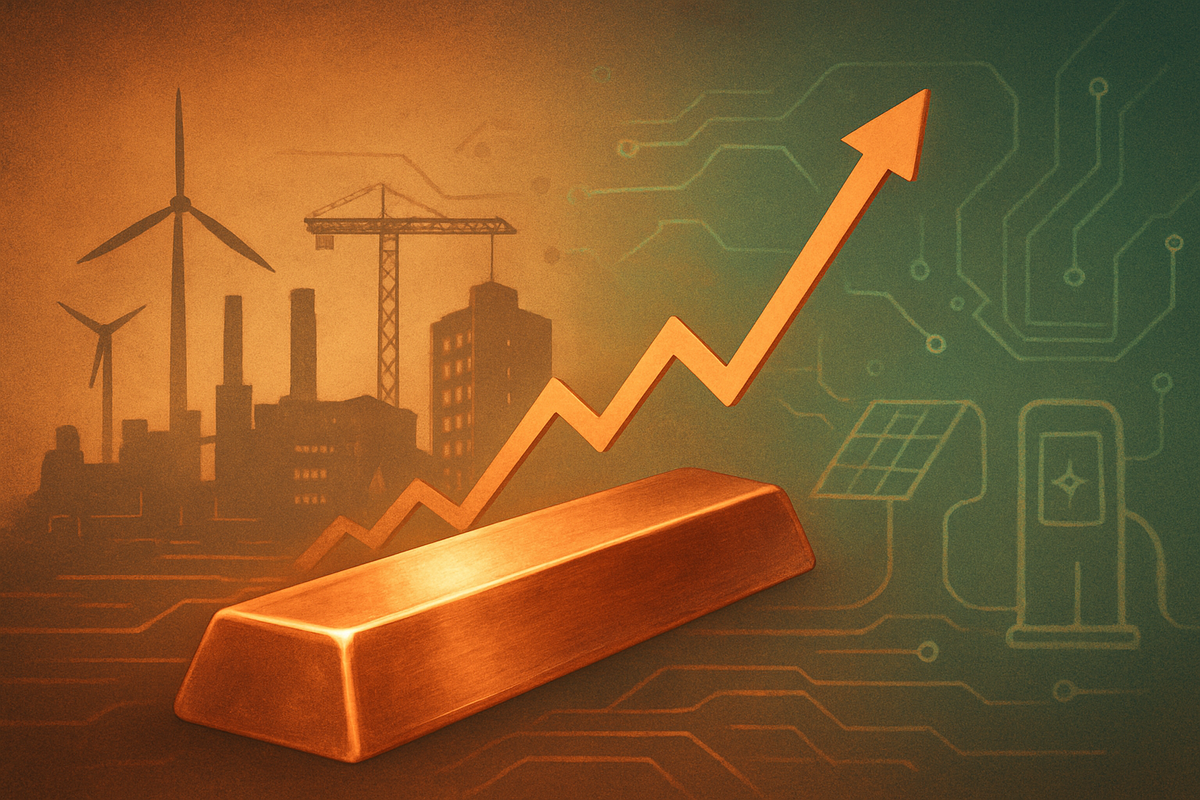
"Dr. Copper," the venerable nickname for the industrial metal, continues to serve as a critical economic bellwether, its price fluctuations often signaling the broader health and trajectory of the global economy. As of November 19, 2025, copper prices are exhibiting a robust upward trend, reflecting a dynamic interplay of surging demand driven by the global energy transition and persistent supply-side pressures. This surge in the price of the red metal carries immediate implications, suggesting a resilient global economic expansion, albeit with potential inflationary pressures and significant impacts on industries reliant on this foundational commodity.
The metal's unparalleled conductivity and malleability make it indispensable across a vast array of industrial applications, from construction and electronics to transportation and power generation. Unlike precious metals, whose values can be swayed by speculative sentiment, copper's demand is directly tethered to tangible economic activity, making its market movements a reliable diagnostic tool for economists and investors alike. Its current trajectory not only points to ongoing industrial strength but also underscores the accelerating pace and increasing cost of the global push towards decarbonization.
Copper's Unprecedented Rally: A Deep Dive into Market Dynamics
The current bullish sentiment surrounding copper prices is a direct consequence of several converging factors. On November 19, 2025, copper was trading around $5 USD/Lbs, marking a significant 20.72% increase over the past year. Earlier in November, London Metal Exchange (LME) copper prices even touched an unprecedented US$11,200 per tonne before stabilizing around US$10,800 per tonne. This upward trajectory is largely fueled by the accelerating global shift towards electrification and decarbonization. Copper is an indispensable component in electric vehicles (EVs), renewable energy infrastructure like solar panels and wind turbines, and the extensive modernization of electricity grids, creating a powerful, almost inelastic demand curve that is set to continue for the foreseeable future.
Historically, copper has proven its diagnostic prowess. During the 2008 global financial crisis, copper prices plummeted from $3.94 per pound in April 2008 to $1.31 by December, accurately foretelling the severe economic contraction. Its subsequent rebound to a record $4.58 per pound by 2011 mirrored the global economic recovery. Today, the factors influencing copper prices are more nuanced. Beyond the green transition, persistent supply constraints are playing a significant role. Mining disruptions, particularly in major producing nations like Chile, coupled with the lengthy and capital-intensive process of developing new mines, are creating a structural supply deficit. Regulatory barriers and geopolitical factors, such as the US adding copper to its critical minerals list in November 2025, further complicate the supply landscape.
Adding to the demand-side strength is a renewed sense of optimism surrounding China's economic outlook. As the world's largest consumer of copper, China's infrastructure investments and manufacturing support policies are providing a substantial boost. While short-term volatility persists due to global macroeconomic concerns and a firmer US dollar, the overall consensus among analysts is bullish. JPMorgan Chase (NYSE: JPM) projects prices to reach US$12,000 per tonne in Q1 2026, while Chile's state copper commission, Cochilco, has increased its forecasts to record highs for 2025 and 2026, citing weak production and demand outpacing supply. The recent reopening of the US government in mid-November 2025, after a 43-day shutdown, also injected optimism, contributing to copper's firming price by signaling expectations of revitalized infrastructure spending.
Winners and Losers in the Copper-Driven Economy
The current bullish copper market, characterized by strong demand and tight supply, creates distinct advantages and challenges for various public companies across the value chain. As of November 2025, copper prices around $5 USD per pound (approximately $11,200 per tonne) are reshaping profitability and strategic decisions.
Copper Mining and Refining Companies: The Primary Beneficiaries
Mining giants stand to gain significantly from sustained high copper prices. Companies like Freeport-McMoRan (NYSE: FCX), one of the world's largest publicly traded copper producers, are seeing enhanced profitability. In Q3 2025, higher commodity prices significantly boosted FCX's revenue and net income, with every $0.10/lb change in copper price impacting cash flows by $80 million. Similarly, BHP Group (ASX: BHP), the world's largest copper producer, saw copper contribute a remarkable 45% to its total underlying EBITDA in FY25, a substantial increase. BHP is aggressively investing in expanding production at its Olympic Dam and Escondida mines. Rio Tinto (ASX: RIO, LSE: RIO) also delivered strong copper production in Q2 2025, with its Oyu Tolgoi mine on track to become the fourth-largest globally by 2030. These companies are well-positioned to capitalize on the structural demand growth, though they must navigate production challenges, geopolitical risks, and high capital expenditure. Southern Copper Corporation (NYSE: SCCO) with its low production costs and vast reserves, is also a significant winner. In contrast, Glencore (LSE: GLEN) has faced challenges, with copper production declining for the fourth consecutive year, impacting its profitability and stock performance, highlighting the importance of operational execution even in a strong market. Other significant players like Teck Resources (TSX: TECK), Hudbay Minerals Inc. (TSX: HBM), KGHM Polska Miedz (WSE: KGHM), and Hindustan Copper Limited (NSE: HCL) are similarly affected by these price dynamics.
Copper Refining and Manufacturing: Navigating Increased Costs
For dedicated copper refining and manufacturing companies, the picture is more mixed. While strong demand from downstream industries ensures robust business, higher copper prices translate directly into increased input costs. This can compress margins if companies cannot effectively pass these costs onto customers. However, the anticipated sustained high demand for refined copper and potential supply shortages could allow them to maintain or even improve pricing power. Strategic decisions in this sector often involve investing in efficiency improvements, securing long-term supply contracts, and exploring backward integration where feasible. India's copper industry, for instance, is seeing investments from companies like JSW Group and Adani to address supply gaps and reduce import dependence.
Copper-Reliant Industries: The Cost Challenge
Industries heavily reliant on copper face the challenge of managing elevated input costs. Electric Vehicle (EV) manufacturers, such as Tesla (NASDAQ: TSLA), BYD (HKG: 1211), Volkswagen (XTRA: VOW3), General Motors (NYSE: GM), and Ford (NYSE: F), are particularly impacted. An average EV uses nearly 70 kg of copper, and rising prices directly increase production costs, potentially leading to higher vehicle prices or squeezed profit margins. These companies are actively engaged in "thrifting" strategies, reducing copper content per vehicle through efficiency improvements and substitution with materials like aluminum. Similarly, Renewable Energy Developers, including NextEra Energy (NYSE: NEE), Enel (BIT: ENEL), Orsted (CPH: ORSTED), and Vestas Wind Systems (CPH: VWS), face higher material costs for solar panels, wind turbines, and grid infrastructure, which can affect project profitability. The Construction Industry, with its extensive use of copper in wiring and plumbing, also experiences increased expenses for building materials. These sectors must adapt through innovation, strategic sourcing, and potentially passing on costs to consumers to maintain viability in a high-copper-price environment.
Wider Significance: Copper at the Nexus of Economic Growth and Green Transition
Copper's enduring role as an economic bellwether is amplified by its central position in the global energy transition and decarbonization efforts. Its price movements are no longer just a barometer of industrial activity but also a critical indicator of the pace and cost of the world's shift towards a sustainable future.
The global push for net-zero emissions places copper at the very heart of this transformation. It is an indispensable component in electric vehicles, wind turbines, solar panels, and the vast network of power cables required for modern energy grids. Current projections indicate that global copper consumption, currently around 25 million tonnes annually, could nearly double to 50 million tonnes per year by 2050 to meet decarbonization targets. This escalating demand is creating a significant supply-demand gap, with analysts projecting potential shortfalls of 3-4 million tonnes by 2030 and up to 10 million tonnes by 2035. This looming scarcity, coinciding with the critical decade for climate action, poses a serious risk, potentially delaying renewable energy deployment and increasing clean energy infrastructure costs by 15-25%.
These dynamics have profound ripple effects. While high copper prices incentivize increased investment in mining exploration and recycling, they simultaneously raise the cost of renewable energy infrastructure, potentially slowing deployment in price-sensitive markets. Industries relying on copper, such as EV manufacturers and renewable energy developers, face elevated material costs and supply chain bottlenecks, which could impede their production targets and overall decarbonization timelines. Conversely, the high prices could also spur innovation in material substitution, with alternatives like aluminum and optical fiber gaining traction where feasible, though often with performance compromises.
Governments worldwide recognize copper's strategic importance, leading to its designation as a critical mineral in many regions, including the U.S. in November 2025. This pivot is driving policy implications focused on supply chain security, with nations aiming to bolster domestic refining capacity and diversify away from foreign reliance. Policies like the U.S. Inflation Reduction Act (IRA) indirectly boost copper demand by incentivizing clean energy investments. Furthermore, there's a growing emphasis on Environmental, Social, and Governance (ESG) practices in mining, pushing producers to adopt sustainable methods and reduce their carbon footprint. Historically, commodity price movements have signaled major economic shifts, from the Great Depression's agricultural price collapse to the 1973 OPEC oil embargo's energy crisis. Copper's current trajectory, driven by the unprecedented scale of the energy transition, echoes these precedents but on an amplified scale, signaling not just economic growth but also the increasing costs and challenges of achieving a sustainable global future.
What Comes Next: Navigating Copper's Bullish Future
The future outlook for copper, as of November 2025, points toward a sustained period of elevated prices, driven by an accelerating structural supply deficit that holds significant implications for the global economy and various key sectors. This "new copper age" is characterized by unprecedented demand from electrification and digitalization megatrends colliding with persistent supply challenges.
In the short term (2025-2027), copper prices are widely expected to remain elevated. Forecast models generally predict prices to stay above $10,000 per tonne, with investment banks anticipating prices reaching between $11,000 and $13,500 per tonne by 2026-2027. JPMorgan Chase forecasts copper prices could hit $12,000 per tonne by early 2026, citing expanding investment in renewable energy, electric vehicles, and AI infrastructure. The long-term outlook (2028 and beyond) is overwhelmingly bullish, with conservative estimates around $13,000 per tonne by 2030, and more aggressive "bull cases" projecting prices could reach $17,000 per tonne. This sustained rally signals profound structural changes in how economies consume raw materials, contributing to broader inflationary pressures and complicating central bank efforts to manage inflation.
These dynamics necessitate strategic pivots across industries. Copper mining companies will need to accelerate exploration and development, maximize output from existing mines, and embrace advanced technologies like AI and automation to enhance efficiency and meet ESG standards. Strategic alliances and mergers and acquisitions will also be crucial for securing resources. For copper-consuming industries, adaptations include implementing strategic sourcing and diversification of supply, investing in R&D for alternative materials, and increasing copper recycling efforts to supplement primary supply. The growth of Electric Vehicles, Renewable Energy, and particularly AI Infrastructure and Data Centers, will continue to be massive demand drivers, escalating production costs for manufacturers and developers in these sectors.
Market opportunities abound in this environment, driven by the electrification megatrend, emerging market growth, and investment incentives spurred by high prices. Copper's role as an inflation hedge also presents opportunities for investors. However, significant challenges persist, including declining ore grades, the lengthy development cycle for new mines (up to 20 years), geopolitical and regulatory risks, and supply chain constraints, particularly China's dominance in refining. The overwhelming consensus points to a significant supply deficit, potentially reaching 6.5 million tonnes by 2031, which means even very high prices might be needed to incentivize new supply, which will take years to materialize. This imbalance is expected to keep copper prices high, making it a critical strategic resource with profound implications for global economic stability and industrial development.
Wrap-up: Dr. Copper's Enduring Prognosis for a Changing World
As of November 2025, "Dr. Copper" delivers a clear prognosis: a robust, albeit complex, global economy undergoing a profound transformation. The key takeaway is a market defined by a powerful confluence of accelerating demand, primarily from the global energy transition and the booming AI sector, set against a backdrop of persistent and structural supply constraints. This dynamic has propelled copper prices to unprecedented levels, firmly establishing the red metal not just as an economic indicator, but as a critical strategic commodity for the decades to come.
Looking forward, the market assessment points to a sustained bullish outlook for copper. Forecasts consistently project prices to remain elevated, with a significant supply deficit expected to intensify through the early 2030s. This imbalance is driven by the sheer scale of demand from electric vehicles, renewable energy infrastructure, and the massive power requirements of AI data centers, juxtaposed with aging mines, declining ore grades, and lengthy lead times for new mine development. While recycling efforts are increasing, they alone cannot bridge the widening gap, suggesting that high prices will be a necessary incentive for new supply.
Copper's lasting impact is monumental. It is unequivocally at the heart of the global energy transition, indispensable for achieving net-zero emissions targets. Its designation as a "critical mineral" by the U.S. Geological Survey in November 2025 underscores its strategic importance for national security, energy independence, and the infrastructure of the future. The copper industry directly employs millions and contributes significantly to the global economy, making its health a direct reflection of worldwide industrial vitality.
For investors, strategic engagement with the copper market is essential. In the coming months, watch closely for Chinese economic data, global manufacturing PMIs, and the strength of the US dollar, as these will influence short-term volatility. Monitor copper inventory levels on major exchanges, and critically, track progress in global renewable energy deployment and EV adoption rates, which are the primary drivers of structural demand. Be aware of risks such as geopolitical instability, potential global economic slowdowns, and unexpected supply disruptions. Opportunities lie in the long-term structural growth driven by megatrends, the potential for copper as an inflation hedge, and investing in well-positioned mining equities or specialized ETFs. Copper is poised to remain a pivotal commodity, dictating the pace of global transformation and offering compelling opportunities for astute investors.
This content is intended for informational purposes only and is not financial advice


















